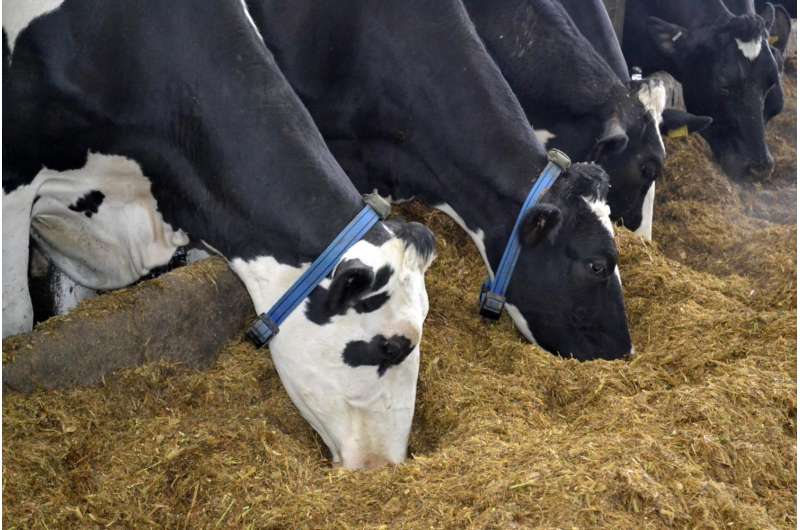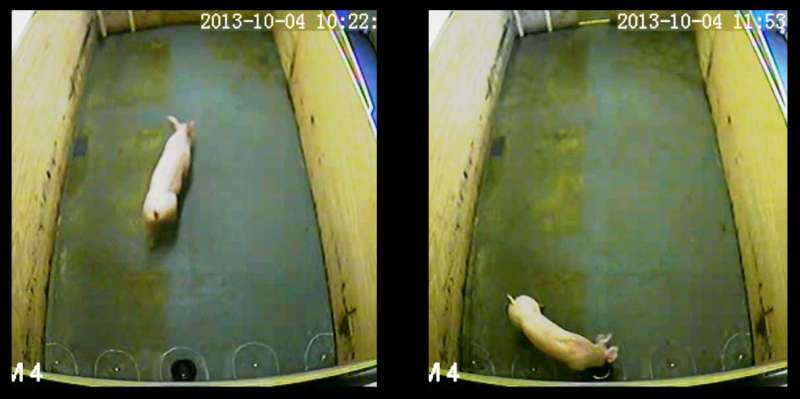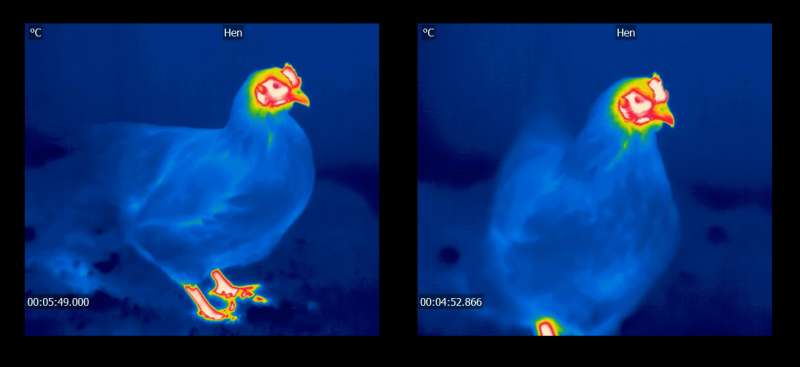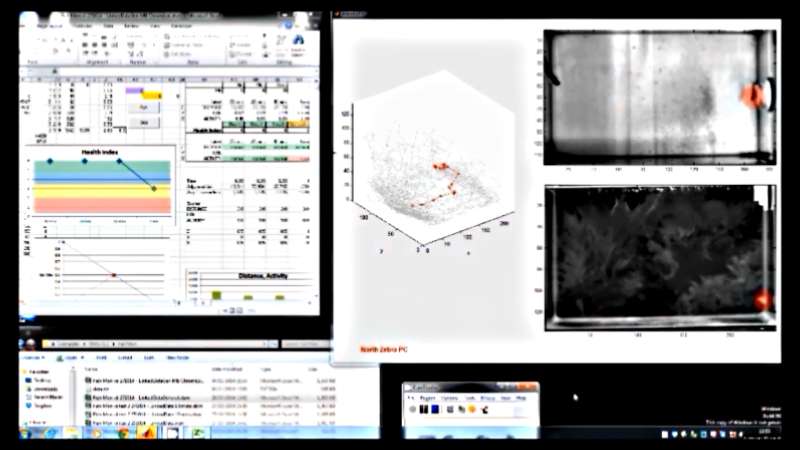How can you tell if an animal is happy or sad?

It's easy to tell when your friends and family are ecstatic or upset. People are human-centric, and hardwired to pick up the physical cues and social signals that indicate relaxed or stressed states.
But animals have their own world of signals that are hard for us to pick up on. Not only that, they have a life-or-death interest in hiding their true physical state from predators further up the food chain, including people.
"The thing about cows and sheep is that as plains-living herd animals they are very discrete with their health problems, so they aren't so obvious a target for predators," says Dr Jonathan Amory from Writtle College. "That means you don't get much by way of obvious behaviour – even for 10 seconds unless they are very unhealthy or very stressed."
And it's this silent, but potentially significant, number that might be suffering that animal welfare scientists like Amory and his team want to know how to find. Humans get a lot from animals – from food to leather and wool to waxes – and our relationship with domesticated animals goes back centuries. It's only right that we look after them and protect them from suffering and disease throughout their lives – especially if they are going to make the 'ultimate sacrifice' and grace our plates.
BBSRC-funded research groups across the UK are using innovative new techniques to get a closer and more accurate look at an animal's welfare state, particularly those relevant to farming and agriculture.
Cows say more than "moo!"
Amory's team is developing a cow-tracking project in collaboration with the University of Essex, Royal Veterinary College and the University of Exeter that can autonomously monitor their behaviour over prolonged periods. "The aim of the project was to identify behaviours in dairy cattle which could be used as predictors for common diseases like lameness and mastitis," says Amory.
To do this, his team have used a new type of cow-mounted biosensor that combines real-time local positioning, a 3D accelerometer to sense movement, a magnetometer for orientation, and a temperature sensor. This smartphone-like package is then worn around an animal's neck and has been capturing the cows' activity budgets, their proximity to herd mates and the locations of these interactions.
"We are finding changes in behaviour associated with diseases," Amory explains. "We also know that there is very wide variation between individual cows and also between days for individual cows, so this may well give us more questions to ask of the data."
The sensors each collated over 1 million rows of data each day, and the team is only now beginning to analyse the data in full. Challenges along the way ranged from everything from limited battery time, to working out the best place on a cow to mount the sensors so they could tell whether the cow was standing or lying. "We had think 'inside the box' for this one," says project research assistant Dr Zoe Barker. "The solution was small plastic boxes filled with sensors and extra batteries, lots of sewing, and even more gaffer tape!"
Being aware of abnormal behaviours might be a quick way for farm workers to take a closer look at an individual, and in the future the system is easily adaptable to send farmers or vets instant updates of an animal's health, welfare and location.

A pig's-eye-view
Attaching sensors and monitors to animals is nothing new – these days they are smaller, less intrusive and collate and send more data than the more cumbersome radio transmitters of old. But there are still inventive ways to use these devices.
Dr Lisa Collins' group at the University of Lincoln used a GoPro camera to capture a pig's eye view of the animal's environment and their experimental set-up (see video above) before their main experiments began. "This was to determine whether there were any distractions at eye level that could potentially affect our study later on," she explains.
Her team are using a combination of cross-disciplinary techniques to investigate how individual animals respond to particular conditions, including information processing and personality assessment, as well as mathematical, statistical and systems-modelling approaches.
In one of their experiments animals had been trained to run to one location (either far left or far right) to receive a reward (M&Ms) from a bowl, and to avoid the bowl when it was in the opposite location, where it contained something they like less (coffee beans). As seen in the video on this page, the bowl was exactly halfway between the place they usually get M&Ms and the place they get coffee beans. "We see how two different pigs interpreted this ambiguous location, and decide whether it is likely to yield a reward or not, based on how quickly the pig runs to the bowl," says Collins.
Like Amory's team, she's also found differences on the individual level. "We've known for a long time that there is a great deal of variation in indicators of animal welfare between individuals, but we are only just starting to understand the factors that are driving this variation," she says.
Emotional and cognitive processes in humans are well studied, and Collins' group is using analogous studies in animals, as described and seen above, to determine whether the processes observed in humans are also shared by other species. "Previously, it has been suggested that animals in a better mood would interpret an ambiguous stimulus more optimistically than animals in a worse mood," she says. "We find that whilst this is true, animals can also have more optimistic or pessimistic personalities, and that they combine these predilections with their mood to interpret ambiguous stimuli."
This means that while elements of a response to a stimulus may remain consistent, other elements of that response may have the potential to vary – just as in people. "By maintaining both stable and flexible traits in their responses to unknown features in their environment, humans and animals are able to respond appropriately to both constant and changing aspects of their surroundings," says Collins. "How this impacts on animal welfare is as yet unknown. We are only just starting to scratch the surface of this research area, and there is a vast amount we are yet to uncover."
The stress is cool
Other BBSRC-funded researchers have been looking into novel ways to find out if an animal is stressed. Chickens are a challenging target, because they typically share their barns with thousands of other chickens, so individuals are harder to observe.
Dr Dorothy McKeegan and her group from the University of Glasgow have been experimenting with infrared thermography technology (IRT) – a 'heat camera' – that shows the relatively hot and cooler parts of the chicken through the colours of the visible light spectrum.
"Infrared thermography technology is a promising welfare assessment measure largely because it allows us to assess stress in a completely non-invasive way," she says. "This means we can potentially assess welfare from a distance, without physical interference with the animals, over a long period of time."
It works because of a phenomenon in endotherms (warm-blooded animals) called stress-induced hypothermia, where core body temperature rises after stress exposure as blood flow is directed to the body's organs and away from the surface – in preparation for a flight-or-fight response, for example. Following a stressful stimulus (such as handling or a sudden, unfamiliar sound), the IRT is sensitive enough to pick up this surface temperature drop as blood flows to organs. This allows identification of stressed birds and, crucially, gives us an indication of how stressed they are.

However, McKeegan says the technology isn't quite at the stage of being used in a commercial setting. Their experimental studies are following individual hens at present, in a controlled setting, which won't always be feasible. Another problem is that a lot of physiological processes are the same after positive and negative experiences, such as the release of 'stress hormones'.
"This makes these physiological reactions a measure of 'emotional arousal', rather than of whether something is good or bad [valence]," she explains. "One of our hopes is that IRT can tell us more about valence, which would be a really important benefit compared to other physiological measures of welfare."
McKeegan adds that their results are encouraging and with more translational research, infrared thermography has the potential to be used a non-invasive stress measure in commercial settings.
Fish have feelings, too
It's not just livestock animals that deserve attention and awareness of their welfare. "Fish welfare is important, and monitoring has been a neglected area," says Dr Lynne Sneddon of the University of Liverpool.
An estimated 200,000 experimental procedures are performed on zebrafish in the UK each year, principally for developmental studies and toxicology testing for the pharmaceutical industry. One reason they are valued as an experimental model is because humans and fish share many similarities. For example, fish and humans produce cortisol as a hormone, whereas rodents have corticosterone. In addition, using fish is more economical than using mammals, hence the increasing number being used – from 195,000 procedures (7% of the total) in 2004 to 419,000 (11%) in 2014.
"It is therefore vital to ensure this species is properly cared for, not only to safeguard their welfare, but also to ensure data is collected from only healthy individuals thereby increasing the validity of experimental results," says Sneddon.
It's not an easy job with hundreds of different fish in the same tank. So working from a joint BBSRC/NC3Rs call, Sneddon and her colleagues have developed a system that so far can simultaneously and autonomously monitor fish. Future development of the system will be to link an alert system so when errant behaviour from the fish is spotted, so an intervention like adding pain-relieving drugs to the tank can be made.
"The system is designed for use in laboratories primarily so researchers have an accurate means of assessing health," Sneddon explains. "But it first could be adopted by other industries, such as pet fish and public aquaria, where it is necessary and desirable to keep fish in good welfare." Some 4000 freshwater and marine species are kept as pets or held in public exhibits, totalling an estimated 20-25M individual fish.
Animal magic
These are just a few examples of how BBSRC-funded researchers are using the latest technologies – from animal-mounted cameras to autonomous tracking software – to give us never-seen-before insights into animals' internal states.
Dr Francoise Wemelsfelder from Scotland's Riral College (SRUC) says we can measure welfare on many levels, in terms of physical health, behaviour, or the animal's experience. Clearly, understanding what animals feel is not an easy task. "We have to be very careful not to view animals through human-tinted glasses, and make the mistake of thinking they will necessarily experience things the way we do."

Animal welfare is a serious issue in farming and agriculture, and no-one in their right mind would want another sentient being to suffer unnecessarily. By trying to better understand how 'happy' or 'unhappy' animals are, as well as why, we can make sure that we keep and treat animals in ways that minimise stress and maximise wellbeing.
More information: Find out more about BBSRC's work in this area using the links below:
Research briefing: Animal Welfare
http://www.bbsrc.ac.uk/research/briefings/animal-welfare/
News: New projects funded to improve animal health and welfare
http://www.bbsrc.ac.uk/news/health/2016/160413-n-new-projects-to-improve-animal-health-welfare/
Funding: Animal Welfare Research Network call
http://www.bbsrc.ac.uk/funding/filter/animal-welfare-research-network-members-call/
Funding: Animal Health and Welfare (ANIHWA) ERA Net
http://www.bbsrc.ac.uk/funding/filter/animal-health-and-welfare-era-net/
Responsive Mode funding priorities: Welfare of managed animals
http://www.bbsrc.ac.uk/funding/grants/priorities/welfare-managed-animals/


















